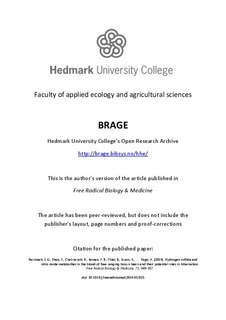Hydrogen sulfide and nitric oxide metabolites in the blood of free-ranging brown bears and their potential roles in hibernation
Revsbech, Inge G; Shen, Xinggui; Chakravarti, Ritu; Jensen, Frank B.; Thiel, Bonnie; Evans, Alina L.; Kindberg, Jonas; Fröbert, Ole; Stuehr, Dennis J.; Kevil, Christopher G.; Fago, Angela
Journal article, Peer reviewed
Permanent lenke
http://hdl.handle.net/11250/277816Utgivelsesdato
2014Metadata
Vis full innførselSamlinger
Originalversjon
Revsbech, I. G., Shen, X., Chakravarti, R., Jensen, F. B., Thiel, B., Evans, A., . . . Fago, A. (2014). Hydrogen sulfide and nitric oxide metabolites in the blood of free-ranging brown bears and their potential roles in hibernation. Free Radical Biology & Medicine, 73, 349-357. doi: 10.1016/j.freeradbiomed.2014.05.025 10.1016/j.freeradbiomed.2014.05.025Sammendrag
During winter hibernation, brown bears (Ursus arctos) lie in dens for half a year without eating while their basal metabolism is largely suppressed. To understand the underlying mechanisms of metabolic depression in hibernation, we measured type and content of blood metabolites of two ubiquitous inhibitors of mitochondrial respiration, hydrogen sulfide (H2S) and nitric oxide (NO), in winter-hibernating and summer-active free-ranging Scandinavian brown bears. We found that levels of sulfide metabolites were overall similar in summer-active and hibernating bears but their composition in the plasma differed significantly, with a decrease in bound sulfane sulfur in hibernation. High levels of unbound free sulfide correlated with high levels of cysteine (Cys) and with low levels of bound sulfane sulfur, indicating that during hibernation H2S, in addition to being formed enzymatically from the substrate Cys, may also be regenerated from its oxidation products, including thiosulfate and polysulfides. In the absence of any dietary intake, this shift in the mode of H2S synthesis would help preserve free Cys for synthesis of glutathione (GSH), a major antioxidant found at high levels in the red blood cells of hibernating bears. In contrast, circulating nitrite and erythrocytic S-nitrosation of glyceraldehyde-3-phosphate dehydrogenase, taken as markers of NO metabolism, did not change appreciably. Our findings reveal that remodeling of H2S metabolism and enhanced intracellular GSH levels are hallmarks of the aerobic metabolic suppression of hibernating bears
